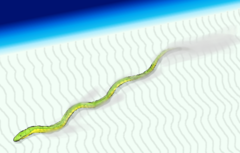Gigantophis garstini
Gigantophis
| Règne | Animalia |
|---|---|
| Embranchement | Chordata |
| Classe | Reptilia |
| Sous-classe | Sauropsida |
| Ordre | Squamata |
| Sous-ordre | Serpentes |
| Famille | † Madtsoiidae |
Gigantophis garstini (le serpent géant de Garstin), seule espèce du genre fossile Gigantophis, est un serpent de la famille de reptiles des Madtsoiidae.
Présentation
[modifier | modifier le code]Il vivait il y a environ 40 millions d'années durant l'Éocène dans le sud de l'Égypte et de la Libye actuelles. L'espèce n'est connue que par un petit nombre de fossiles[1],[2].
Dimensions
[modifier | modifier le code]Il aurait mesuré plus de 10 mètres de long, sa taille approchant ou dépassant celle des plus grandes espèces actuelles telles que le python réticulé (plus de 10 m) ou l'anaconda (presque 10 m). En comparant les vertèbres fossiles de Gigantophis à celles des plus grands serpents modernes, Jason Head de la Smithsonian Institution (Washington, D.C.) a conclu que ce serpent éteint pouvait dans sa croissance atteindre 9,3 à 10,7 mètres de long. Avec 10,7 mètres, il aurait dépassé de plus de 10 % ses parents biologiques les plus grands[3].
Alimentation
[modifier | modifier le code]Gigantophis était constricteur bien qu'il apparût à la même époque que les serpents venimeux. Il se nourrissait de poissons géants mais aussi de Moeritherium, un proboscidien primitif ancêtre des éléphants actuels et de la taille d'un cochon.
Publication originale
[modifier | modifier le code]- (en) Andrews, 1906: « A descriptive catalogue of the Tertiary Vertebrata of the Fayûm, Egypt. Based on the collection of the Egyptian government in the Geological museum, Cairo, and on the collection in the British museum (Natural history), London », British Museum (Natural History), Department of Geology, p. 1-319 (texte intégral).
Voir aussi
[modifier | modifier le code]Liens externes
[modifier | modifier le code]- Ressources relatives au vivant :
Notes et références
[modifier | modifier le code]- (en) Référence Paleobiology Database : †Gigantophis Andrews 1901 (snake) (consulté le ).
- (en) Référence Paleobiology Database : †Gigantophis garstini Andrews 1901 (snake) (consulté le ).
- (en) New Scientist magazine, n° 2473, 13 novembre 2004, p. 17
Text is available under the CC BY-SA 4.0 license; additional terms may apply.
Images, videos and audio are available under their respective licenses.

